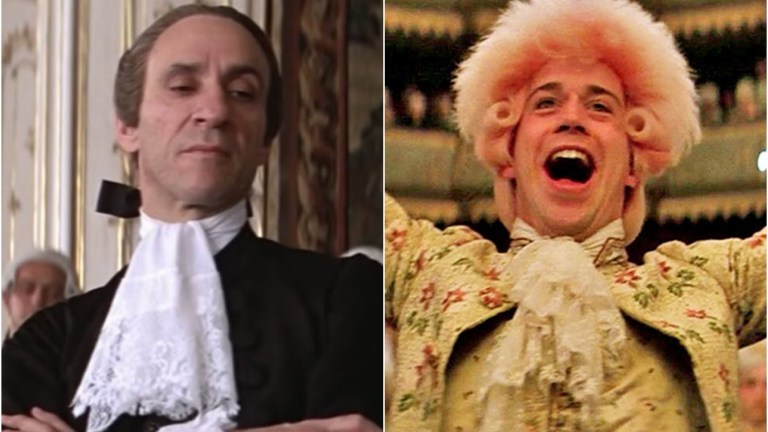Amadeus Is One Movie That Didn’t Need a Director’s Cut
The theatrical cut of Amadeus is a great example of why less is more.

Amadeus, which won the Academy Award for Best Picture of 1984, is about as perfect a film as there is. A combination of historical(ish) drama, palace intrigue, psychological tragedy, and bedroom farce, it is a sublime confection that’s anchored by two of the finest performances in modern cinema and scored by some of the greatest music of all time. To this day, director Miloš Forman’s screen adaptation of a Peter Shaffer play by same name remains a monumental piece of work.
The movie was largely recognized as such, too, when it was released in September 1984 at a running time of two hours and 21 minutes and with a PG rating. At a glance that length and subject matter didn’t exactly resemble conventional multiplex fare, but it was a success, earning $90 million off a budget of $18 million and all the praise and awards that soon followed. Nevertheless, almost exactly 18 years later, in September 2002, a “director’s cut” of the film, featuring around 20 minutes of restored footage that pushed the film’s rating from PG to R, was issued to DVD (as well as all later home video versions of the film).
In an April 2002 interview with The A.V. Club, Forman explained that he originally pared down the film’s length as much as possible since creating a “three-hour film about classical music, with long names and wigs and costumes” was already a sizable risk at the box office. The advent of DVD, however (and perhaps the success of previous director’s cuts from the likes of James Cameron and Francis Ford Coppola), provided Forman a chance to extend the film in a more home-friendly format. “Once we are re-releasing it on DVD, it doesn’t matter if it is two hours and 40 minutes long, or three hours long,” he explained.
While the director is certainly correct in saying that a longer film might go over better with viewers watching comfortably in their homes—where they can stop or pause as necessary—the question regarding the “director’s cut” of Amadeus, and indeed all “expanded,” “extended,” and “restored” editions, will forever be: does it really make the film better? In the case of Amadeus, we think not.
Too many notes?
F. Murray Abraham stars as Antonio Salieri, renowned musician and court composer to Emperor Joseph II of Vienna, who becomes obsessed with the life and work of the young Wolfgang Amadeus Mozart (Tom Hulce). Salieri, who has pledged to God that he’ll live a life of dignity, faith, and chastity in exchange for success and acclaim as a composer, cannot reconcile that the sublime, almost divinely inspired music of Mozart is created by a ribald “creature” he views as immature, irresponsible, and obscene. So in the movie’s entirely fictionalized plot, Salieri secretly and successfully hatches a plan to destroy the young composer, ultimately leading to Mozart’s death at age 35.
Amadeus, both the play and the movie, is not meant to be accurate or truthful to history: Salieri did not contribute in any way to Mozart’s death. Shaffer’s play and Forman’s film, instead, aim to offer up a deeply profound question: is artistic talent or genius truly a gift from the divine, and what price is one willing to pay for it?
“Whatever was not directly connected to the plot, I just cut it out,” Forman told The A.V. Club about his effort to trim Amadeus from three hours to two and a half. Therein lies the key to why the theatrical cut of Amadeus is, in our view, better than the longer home video version. While one shouldn’t sit down to watch the theatrical cut of Amadeus expecting the pace of a summer action tentpole, the movie actually does move quite fluidly and quickly simply because the storytelling and acting are so good. Most of the additional scenes, however, do not add anything essential to the story, which instead becomes slower and more deliberate. So even at just an additional 20 minutes in length, the “director’s cut” seems a bit more sluggish and bloated by comparison.
Some of the excised/restored material is merely extended versions of existing scenes, such as an early discussion between the elderly Salieri and the priest who comes to hear his confession. There is also a longer scene involving the mother of Mozart’s wife Constanze (Elizabeth Berridge), which is more comic relief than anything else, as is a later sequence where Mozart attempts to teach a young student while her father’s dogs ceaselessly bark at him. There are also a number of discussions—between Mozart and Constanze, Mozart and Salieri, Salieri and Baron von Swieten—regarding Mozart’s finances, a theme that becomes overly repetitive in the “director’s cut.”
Salieri and Constanze
A combination of two scenes, however, does provide some crucial character development for two of the film’s leads and adds meaning to the film’s climactic moments. It involves a visit by the fiercely protective Constanze to Salieri’s house where she begs him to help Mozart get an appointment to the emperor’s court. Salieri tells her to return that evening, basically implying that she must have sex with him in return for sponsoring her husband to the emperor.
Constanze reluctantly but self-assuredly returns that evening and begins to undress. Salieri, however, remains the same character who earlier in the film vowed a life of celibacy in order to achieve success. Upon seeing Constanze acquiesce to his sordid demands (and perhaps desires?), the composer grows suddenly indignant. It is unclear if he is pretending to be shocked and outraged to mock her, or whether he is using it to cover his own sense of shame self-digust, but he calls for a servant to lead the bewildered and humiliated woman out—but not before she hurls one of Salieri’s candelabras across his study. The scene shows the lengths to which Constanze will go to help her husband and secure their future, and provides context for why she is so furious to find Salieri at her dying husband’s bedside at the end of the film, upon which she immediately throws him out of their apartment. Her antipathy toward Salieri makes less sense without the scene in Salieri’s study.
The scene, however, also paints Salieri as far more ruthless in his passion to destroy Mozart, by allowing himself the opportunity to degrade Constanze after discovering some time earlier that Mozart had slept with Caterina (Christine Ebersole), the singer whom Salieri was secretly in love with. This more outright evil side of Salieri is also displayed in another restored sequence in which he hints to the emperor that Mozart is molesting his female music students.
So while the restored material does add complexity to the character of Constanze, we’d still argue that it’s the theatrical cut that makes Salieri a bit more sympathetic and layered, thus rendering the tormented, misguided composer more of a tragic figure and less a straightforward villain. Aside from the slightly off-kilter continuity of the scene in the dying Mozart’s bedroom, the film ultimately does not suffer from the loss of the scene between Salieri and Constanze.
Aside from a better pace for what is already a stately movie, the theatrical cut of Amadeus presents a Salieri who is perhaps more subtle in his manipulation of Mozart and the circumstances around him, arguably giving the composer an out for his still nefarious goals. By staying just on the edge of crossing more sinister lines, Salieri can keep rationalizing his behavior to himself—a cynical and self-delusional approach to life that we find to this day among people pretending to be pious, humble, and noble. It’s in that tension that Amadeus finds its meaning, and why the theatrical cut prevails.


